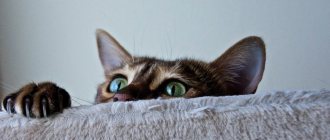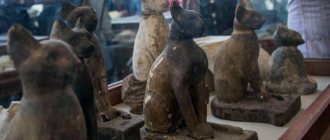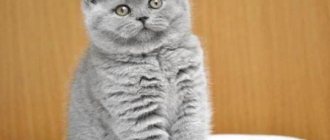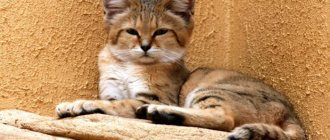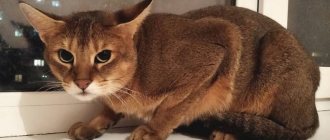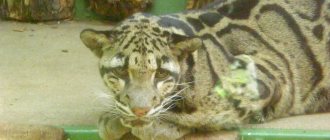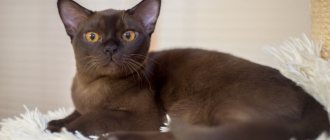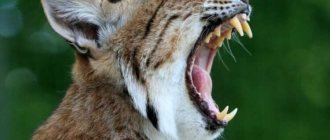People's passion for big, plump cats is inexplicable. Many people are moved by looking at photographs of giant fluffy balls, not realizing that the desire to fatten a cat to incredible sizes causes irreparable harm to his health. Some animals that received the title of “the fattest cat in the world” ended up on the pages of the Guinness Book of Records, although they later decided to remove this category due to fears that owners would deliberately overfeed their pets in order to receive this title.
Large breeds
Today, there are more than a dozen large cat breeds; their representatives are of impressive size and can significantly exceed the standard weight of an ordinary domestic cat of 2.5-4 kg. The table below shows the indicators for each type in alphabetical order.
| No. | Breed name | Male, kg | Female, kg |
| 1 | British Shorthair | 6,0-8,0 | 5,0 |
| 2 | Kurilian Bobtail | 6,0-9,5 | 5,5 |
| 3 | Maine Coon | 5,9-8,2 | 3,6-5,4 |
| 4 | Norwegian forest | 6,0-9,0 | 5,5 |
| 5 | Pixie bob | 5,0-8,0 | 3,0-6,0 |
| 6 | Ragdoll | 7,0-10,0 | 4,0-6,0 |
| 7 | Ragamuffin | 10,0-11,0 | 5,0-8,0 |
| 8 | Savannah | 15,0-18,0 | 7,0 |
| 9 | Siberian | 6,0-9,0 | 3,5-7,0 |
| 10 | Turkish van | 6,0-9,0 | 4,5-6,0 |
| 11 | Chartreuse (Carthusian) | 6,0-7,0 | 4,0-5,0 |
According to some expert research, it is believed that castrated cats are more prone to obesity than animals that have not undergone castration surgery. The same goes for sterilized cats.
Tulle
Nine-year-old Tulle has surpassed previous participants in the ranking of fat cats. The red-haired pet, which has gained 20 kg, lives in Denmark.
A cat, when it lies motionless, can be confused with a small fluffy pillow or ottoman. The owners cannot refuse the cute little cat his constant desire to eat something tasty. Over time, Tulle lost interest in outdoor games and indulged in laziness. It is difficult for the cat to walk, and in order not to get up, he has learned to roll like a ball, and in this way he gets to the bowl of food. Of all the activities, Tulle chooses sleep.
Currently, the hero is following a diet, because his weight is approaching a critical point.
What other large breeds exist?
As we have already found out earlier, there are more than a dozen large breeds of the cat family in the world intended for home keeping. Let's look at a few more representatives of big cats.
British
Among these pets there are short-haired and long-haired individuals. Males weigh up to 10 kg, and females - from 5 to 7. Distinctive features: solid color (gray-blue, black and chocolate), silver tabby, as well as a love of solitude and an independent character.
Siberian
They were found everywhere in the Russian Empire and are still popular in Russia. They have different colors and semi-long hair. The weight of adult cats is about 6-9 kg, females weigh a little less - 5-7 kg.
Turkish van
It is considered an aboriginal representative of the oldest domestic cats. They are also recognized as one of the largest predators of the cat family. The weight of an adult cat can be 8-10 kg, and the body length can be from 90 cm to 1 m 20 cm. The traditional color is red-chestnut. The Turkish van looks noble, but its character is contradictory - sometimes capricious, sometimes affectionate.
Pixie bob
Amazing creatures are very reminiscent of lynx, because this was the purpose of their breeding. They have a neat short tail and an interesting color. Average weight – 5-8 kg. They have a meek and gentle disposition.
Norwegian forest
Distributed in Northern Europe. Quite a large animal weighing up to 9.5 kg. The fur is thick and long, and there are tassels on the ears. The character of the purebred individual is freedom-loving, but friendly, he loves to hunt and play.
Of course, the Savannah and Maine Coon are considered the largest cats, but there are several other breeds that are not far behind the graceful “giants.” Just remember that not only the size of the animal, but also its behavior, health and character depends on the breed.
Maine Coon
Animals of this breed are also called Maine cats. The Maine Coon breed held the title of the largest cat in the world for a long time. An adult individual reached a weight of up to 10 kilograms. A very beautiful individual, similar to both a jungle cat and a wild lynx.
It differs from cats of other breeds in its tiger-like gait and tufts on its ears. It differs from its wild counterparts in its friendly disposition. There is so much kindness and beauty in your home. Even the wild cat, the Pallas cat, is somewhat similar to the Maine Coon.
The heaviest cat in the world - Himmy
The owner of the cat was Australian Thomas Vyse. The weight of the heaviest cat in the world was 21.3 kilograms, the owner drove him in a wheelbarrow around his garden plot. When the animal was measured, it turned out that it was 96.52 centimeters long, almost a meter! Himmi's waist circumference was 83.82 centimeters, and her neck – 38.1 centimeters. For comparison, the norm for an adult man is a neck circumference of about 38.8 centimeters!
The cat did not move well on his own, was extremely lazy and loved to eat. This led to excess weight. Unfortunately, the cat died at the age of 10 from respiratory failure. Apparently, Himmi suffered from heart failure due to his obesity. He left his owner on March 12, 1986. It was after this that this category was closed in the Guinness Book of Records.
Few people know that the record holder had a predecessor. There is more than one heaviest cat in the world in the Guinness Book of Records. There are only two of them!
Everyone knows about Himmy, but before him, the title of heaviest cat was held by the cat Spicy, who lived in Connecticut. Her weight was 20 kilograms, and she died in 1977.
Skinny the cat, who was simply thrown away
The cat weighed 19 kg when he was found wandering the streets of Richardson, Texas. It was in 2012, Skinny was taken to a pet shelter. The clinic determined his age; the cat was about five years old. Veterinarians suspected that the owners had gotten rid of an overweight cat who was very clumsy and lazy.
Skinny found a family in a large house with three children, two dogs and three other cats. He was well cared for and after two years he was down to 11.5kg. He's just smart! Not many people can do that. He was one of the heaviest cats in the world. Photos prove that Skinny looked like a real hero.
Savannah
This breed resembles a wild serval. What makes them unique is their spotted coat. The color is golden or beige, with a lighter undercoat. The silhouette is thin. The legs are muscular, the hind legs are slightly longer than the front ones. The tail is wide, not very long. The Savannah's neck is proportional to the length of the back, slender. The head is triangular and rather small compared to the rest of the body. The ears are set high on the head and large in relation to it. They stand upright, wide, narrow, ending in slightly rounded spines. Medium-sized eyes are set deep, the standard allows all colors of the iris.
Also typical of the Savannah breed are tear-shaped markings around the eyes, which give these cats an exotic, cheetah-like appearance. Savannah is very friendly, playful and sociable. They have a strong need to move and are usually very active, requiring a variety of activities. Therefore, they should be given either different toys or, for example, the company of a second cat. They are also very patient with children.
Savannah can be stubborn and often act on her own. However, they are very attached to their guardian. Due to its temperament, the Savannah is not recommended for first-time owners.
| Savannah breed size chart | |||
| Height at withers (cm) | Body length | Weight, kg) | |
| Cat | 60 | 120 | 20 |
| Cat | 50 | 100 | 15 |
| Kitten (3 months) | 3 |
Savannah should be fed raw meat. But it’s better to freeze it. But it is better to limit cereals and dairy products. At the age of 3 months, the animal can begin to be trained (approximately like a dog).
Prevention
Preventing obesity in cats is quite simple - there are a few simple rules to follow:
- Do not overfeed! And also monitor the quality of the feed. Don't skimp on it. Do not mix or alternate “drying” and “natural”. You can often determine by eye how much food is normal for a cat and how much is not. And even if your plump pet furry demands his portion - be adamant and feed on schedule. Week 2 and he capitulates.
- Don't limit your pet's play. Provide sufficient physical activity, because the cat is a predator by nature and must run to feed itself now. Do not deprive the mustache of this opportunity. They put food in his bowl at the first “meow,” so where does the energy go? Play more often, let the cat run, otherwise he will quickly become fat.
- Change your diet. If your mustache is castrated/sterilized, then be sure to review the diet and choose a special diet. And be sure to play with your furry four-legged friend more often.
SpongeBob
The cat ended up in a New York cattery, where he surprised the entire staff with his weight.
The animal underwent a full examination to exclude the possibility of diseases. And it turned out that the cat was completely healthy. True, the nursery staff are sure that excess weight is not the norm for a 9-year-old cat. And they try to help him get rid of the extra pounds through a special diet and special exercises. Veterinarians expect that losing excess weight will allow the cat to move normally.
Cats from the Guinness Book of Records
There are many fat cats in the world, but not all of them were able to win titles and titles. The owners of some made sure that their pets became famous throughout the world thanks to their excellent appetite and excess weight.
Australian fat man
The largest officially recorded weight of a cat was recorded in Australia. The owner of the record 21.3 kg was a well-fed cat named Snowball, who more closely resembles a huge white snowdrift. The fat animal, despite being overweight, showed miracles of longevity for the following parameters: Snowball lived for 10 years, after which he died due to respiratory failure, which is not surprising. If an adult had the same degree of obesity, his weight would exceed 270 kg.
Otto
In second place is a cat living in America. The owner took his fat pet Otto to the veterinary clinic in order to euthanize the animal, since the cat had become so fat that he had difficulty moving around the house and could not go to the toilet on the tray, since his butt no longer fit there. The veterinarians persuaded the man not to euthanize the pet, but to try to gradually limit his food intake to stabilize his body weight. After six months of following a special diet, the fat man was able to lose significant weight, which made his life much easier, but pushed him out of the rankings.
Record holder Meow
Third place in the Guinness Book of Records was taken by a cat with the funny name Meow, who was the size of a medium-sized dog. He was only one and a half years old when his previous owner, who lived in Santa Fe, turned to a cat shelter to transfer a problem animal to specialists for permanent residence.
The fat pet reached a weight of 18 kg, which made caring for him more difficult, especially considering the woman’s advanced age (at that time she was 87 years old). Specialists began to adjust his diet and tried to return the animal to normal parameters. Meow has become the star of several shows and television programs dedicated to the rules of nutrition for pets. A strict diet helped him get rid of several kilograms and soon there were people who wanted to take home the popular cat, but the consequences of obesity made themselves felt: Meow died in a shelter at the age of two due to pulmonary failure.
Spongebob square….belly
The fourth position belongs to another American resident - a fat red cat named SpongeBob. The weight of this nine-year-old pet is 15.5 kg. Unlike previous heavyweights, a medical examination showed that all his health indicators were in impeccable condition. But in order to avoid possible problems in the future, experts recommended adjusting the diet and putting the fat cat on a diet, since extra pounds can cause pathologies in the joints, muscles, etc.
Elvis
Elvis the cat, who, alas, is not included in the Guinness Book of Records, since this category was banned in 2015 due to the risk to the lives of pets whose owners deliberately feed their animals. This fat man is German and lives in Germany. At the moment, Elvis has reached a weight of 17.5 kg, which exceeds all acceptable standards. Because of the extra pounds, he has a whole bunch of diseases - from diabetes to muscle tissue atrophy. He moves with great difficulty, has breathing and heart problems, so the owners intend to take his nutrition seriously and gradually achieve weight loss, which will extend the years of Elvis’s life. A special advisory group of four veterinarians has been created to monitor his health and rate of weight loss.
Despite the fact that fat cats look very funny and make us touch, many animal rights organizations warn that the task of a caring owner is to keep their pet's weight under control, because obesity can lead to many diseases and, as a result, , to an early death.
Xiong Yurong
A fat cat named Xiong Yuzhong comes from China. The mustachioed pet's body weight is 17.5 kg, which does not bother the owners at all. They admit that they dote on him and continue to indulge the cat’s unhealthy appetite, including a portion of fresh meat in the animal’s diet, the minimum portion of which is a kilogram.
Xiong Yuzhong is not interested in either mice or adventures on the street. This rotund glutton's favorite activity is to sit on the couch and watch those around him fuss.
The most expensive cat breeds
If you are engaged in breeding and maintain a private nursery, then a fairly important issue is the purchase of breeding individuals, the offspring of which will bring good profits. We present a list of the most expensive cats today.
- Devon Rex is a very interesting feline, a bit like a sphinx. Small animals with short, soft fur that resembles velor, and large ears. Very smart, easy to litter train. In addition, their fur does not cause allergies. Cost – from 400 dollars.
- The Himalayan cat is a beautiful, long-haired animal. Cost from 500 dollars.
- Scottish Fold - they are distinguished from other breeds by the structure of their ears: they are curved forward and downward. In addition, these pets do not purr, but squeak. And one more feature: they like to sit in a position atypical for cats, with a straight back and outstretched paws. The price ranges from $200 to 1500.
- The Canadian Sphynx is a hairless cat, very graceful and agile. Owners are often surprised by their pet’s ability to freeze for a long time in the most bizarre pose, as if deep in thought. Cost – from $400 to 1500.
- The Maine Coon is one of the largest cats on earth. The body length reaches 1.2 meters, and the weight is more than 15 kg. Their black striped color (not always, but quite often) and huge, bushy tail make them look like raccoons. From $600.
- The Elf is a recently developed breed of completely hairless cats with folded skin and large ears that curl back. From 2000 dollars.
- The American Curl is a long-haired breed characterized by ears that are curled up like horns. From $1000.
- Bengal cat. Luxurious leopard-colored fur is the main advantage of the breed. From $1000 to 4000.
- Khao Mani, an ancient Thai breed. From 7000 dollars.
- Chausie is the result of crossing a domestic cat and a swamp lynx. Very rare animals that amaze with their grace and sociability. From $8000.
- Savannah is the most expensive pussy in the world, the result of crossing an African serval and a domestic cat. An elegant, large animal, a real domestic leopard. The cost depends on the class of the kitten, ranging from $4,000 to 22,000.
These are not all the very best cats that live next to us. Surely each of you can add to the list by including your pet in it. Big or small, fluffy or smooth-haired, they are waiting for us from work and purring joyfully, basking on our laps. Perhaps the only distinguishing feature that needs correction is your pet's weight. And don’t let the title “fattest cat” touch you. The photo, of course, may represent a funny animal with a blissful face, spreading across the sofa, but in reality, excess weight often leads to the early death of a pet.
How to prevent your cat from becoming obese
Obesity is defined as more than 15-20% excess weight, which is less than 1 kg of excess body weight for the average cat. Strict control over the amount of food is the only way to prevent obesity in your pet. This rule is important for castrated animals, because sex hormones no longer reduce appetite. Do not feed according to the principle: let him eat as much as he can. The animal does not understand that it has eaten more than it needs.
Excess fatty tissue in the body leads to disruption of the functioning of all internal organs of the animal. This interferes with freedom of movement, forcing the pet to lie down more. Obesity is dangerous due to overload of the heart and blood vessels, which ultimately shortens the cat's life.
Diseases of cats caused by excess weight:
- replacement of healthy liver cells with fat cells (lipidosis);
- joint inflammation (arthritis);
- renal failure;
- pulmonary edema;
- inflammation of the pancreas (pancreatitis);
- diabetes.
https://www.youtube.com/watch?v=Uo6L3O5J1tQ
Fat cats cannot groom themselves or use the toilet properly. If surgery is necessary, the use of anesthesia can be fatal.
The habit of eating a lot not only causes obesity, but also makes it difficult to reduce your pet’s weight to normal. Desperate, the owner surrenders to the mercy of the pet. A friend of mine had a mongrel cat who loved to sleep and eat. When the owner finally brought her lazy pet to the veterinarian for examination, he began to talk about cruelty to animals.
And not in vain - the plump fat woman weighed more than 9 kg, but there were no serious health problems yet. The doctor prescribed a diet for weight loss. The hungry cat endured the first day, thinking that they forgot to buy her food. When she realized that the hostess was to blame, a riot began. Heaps and puddles appeared on the floor and in the corners of the apartment every day.
It seemed that the cat had forgotten about the existence of the tray. Wanting to return to her previous nutrition, she began to disturb her owner’s sleep by climbing onto her bed at night. Then the teeth came into play: after eating a small portion of food, the cat bit the culprit of her troubles on the legs, demanding more. I had to buy a spacious cage and lock the ugly creature at night.
But even then she came up with a way to annoy her: she began to meow loudly. Her hungry stomach gave neither her nor those around her rest. The neighbors were patient, but a few days later they called the police. I had to give explanations. After two weeks of “war” with the cat, the owner gave up and began feeding her as before. It was not possible to correct the previously committed mistake in keeping the animal.
Excess weight is bad for any pet, not just cats. With severe obesity, the internal organs are tense, and the muscles cannot support the weight. Because of this, it hurts the cat to get up and walk, and his back sags under the weight of his belly. Fat people are 4 times more likely to have diabetes. In the worst cases, animals die from cardiac and respiratory arrest.
cat Springles from the USA - that’s it, a well-fed cat won’t have a sweet dream anymore, I’m big, not fat
In healthy cats, appetite, or the feeling of fullness in the stomach, is regulated by leptin, a digestive hormone. What exactly disrupts its function is still unknown. Unfortunately, in many cases, veterinarians do not find medical causes of obesity in pets, they only diagnose complications. Owners often encounter cats asking for food all the time. Science is trying to find an explanation for this, but so far without success.
We invite you to familiarize yourself with the Care and maintenance of the bear-type dwarf Pomeranian Spitz
A fat cat evokes affection in most people. It is sometimes difficult for the owner to resist adding food when the pet asks to eat again. Maintaining a normal weight increases the lifespan of your pets. It is easier to prevent obesity than to treat it for a long time and not always successfully.
Weight standards for cats
Overweight is common in cats, just as it is in people. Multiple causes of this disease can lead to various diseases and pathologies, so owners of furry pets need to monitor their nutrition and health.
Obesity in a cat
What does a cat’s body weight depend on:
- Breed. It is worth noting that each member of the cat family has its own weight norm. Large breeds such as the Maine Coon weigh much more than their miniature counterparts (Persians, Sphynxes, etc.).
- Floor. Most often, a boy, for example a British breed, has a larger mass than a girl of the same breed. Males are generally larger than cats. The difference can be about 2 kg.
- Castration and sterilization. After these operations, the animal’s hormonal background changes, and therefore weight begins to increase.
- Diseases. Obesity can be a consequence of any disease or dysfunction of internal organs.
- Age. Young cats are smaller than older cats because they are more active and healthy.
- Constitution. The physique of cats is also individual: some are more muscular, while others are thin and graceful.
- Nutrition. Pets should be fed a balanced and high-quality diet.
- Lifestyle. Sedentary animals always weigh more than active ones.
Important! The most common breeds that are prone to gaining excess weight are Sphynxes, Britons, Persians, Exotics and Burmese. Owners of such breeds should be careful to prevent them from becoming obese
How can you determine if your pet’s weight is normal? A fat cat has a noticeably large belly (apron), no waist, and a large muzzle. The ribs of such animals cannot be felt under the fat layer. A cat with a normal weight is active, he has a proportional body with a waist, the bones are palpable, but do not stick out.
Comparison of a healthy cat and an obese cat
The average weight for newborn kittens is 70-140 g. Gradually, they begin to add 15 g per day, and then 100 g by 2 months. Plump kittens are quite rare, as they are very active and their metabolism is still fast.
In a year, a cat will gain weight, which will remain there for many years to come if you monitor its health. To understand the norm of weight, we can take several fairly common breeds as an example. By the first year of life, a large representative of the Maine Coon reaches from 5.3 kg to 8.8 kg, and a representative - from 4.5 to 8.3 kg. Small British cats weigh about 2.5 - 4.6 kg, and male cats - 4.5 - 7 kg. The average-built Siberian breed weighs from 4.5 to 7 kg, regardless of gender.
Note! It is not worth making final conclusions about the weight of an animal based on the established average if it looks healthy and well-built. A cat that is too thin and has protruding bones cannot be healthy either.
Diseases can also develop from malnutrition, as well as from overeating.
What are the dangers of obesity for a cat?
Videos and memes of fat cats sometimes become very popular, but in reality there is nothing very cute or funny about your beloved pets if they are obese. Although an adult cat's plump belly may not seem like much, these extra pounds can lead to very serious complications and cause serious harm to health in both the short and long term. There's no denying that the overweight cats you see on Instagram and YouTube are cute, they're just not healthy. The sad truth is that being overweight causes them a lot of suffering, and their owners need to provide them with the help they need, in addition to lots of “likes” on social media.
Overweight cat
The causes of obesity in cats are similar to those in other mammals such as dogs, horses and humans; This is usually an imbalance in caloric intake and activity level. In other words, most creatures gain weight when they eat more calories than they can burn. There are additional factors that contribute to this, such as neutered and spayed animals have a harder time losing weight because their metabolism slows down after the procedure. Animals that require medication may require more careful control of portions and activity levels, and isolated animals usually have a harder time losing weight. The same goes for animals that are stressed. Just like people, they can “eat” it. Additionally, the older a cat gets, the less active she is, and her metabolism also slows down.
The problem of feline obesity must be addressed quickly, as it is associated with a real health threat. Obese cats are at greater risk of developing various diseases such as diabetes, liver disease, arthritis, urinary problems, lameness, pancreatitis and gastrointestinal diseases of all types, as well as skin problems such as dandruff. Fat cats have a decreased quality of life and an increased risk of cancer.
The best way to treat obesity in pets is to prevent it in the first place. It may seem fun to feed your cat treats or food from your table all the time, but it is better to avoid consuming unnecessary and harmful foods, and also limit your cat's diet to special food, and set portion sizes in accordance with recommendations.
Weight standards for cats and cats
According to international standards, the average adult cat has a total length of 71–73 cm, of which the tail is 28 cm, and weighs 2.8 kg (6.2 lb). An average adult cat with a total body length of 66 cm weighs 2.45 kg (5.4 lb). Its tail is about 24 cm. Neutered pets are heavier - from 3.2 to 5 kg. Their life processes are slowed down and energy consumption is less. To determine the normal weight, measure the length of the cat's body from the tip of the nose to the beginning of the tail and divide the result by 16. The resulting value is compared with what the scales show. If a pet is 800 g heavier, it is a sign of the onset of obesity. An animal’s body weight at one and a half years is an approximate guideline for its entire life. At this age, most breeds stop growing.
The normal weight of a cat depends on:
- on the quantity and composition of food;
- from physical activity;
- from the innate characteristics of the animal.
In large Maine Coons, the weight of castrated cats reaches 11.5–13.6 kg compared to animals for breeding. The standard for this breed is 4–5 kg for cats and 6–8.5 kg for males. Massive Ragdolls and Britons weigh up to 7–9 kg (males) and 5.5–6.7 kg (females). Neva Masquerade cats weigh 8 kg, and male cats are half that size, which corresponds to the norm. Male Siamese weigh no more than 5.5 kg, and male cats weigh up to three kilograms. A bobtail kitten normally weighs up to 3 kg at 4 months, and an adult cat weighs up to 7 kg. If the pet belongs to the miniature breed of cats (Singapore Drain Cat), then the weight of an adult animal does not exceed 2.8 kg when it is healthy.
Metabolic processes in adult cats may differ, as well as energy expenditure. Young animals play more, especially in the evenings in the presence of their owners. For them, spending 80 kilocalories of energy per kilogram of weight is the norm. From it the owner calculates the daily portion of food for the pet. To satiate a cat weighing 3.5 kg, 50 g of premium dry food and 150 ml of water per day are enough. It is more difficult if you feed homemade food. For a healthy animal weighing 3–5 kg, 200–250 g of chicken or beef per day is enough. Lazy representatives of the cat family spend 55–60 kcal per 1 kg of body weight and the portion of food for them is smaller.
A healthy pet with a normal weight has a noticeable waist. When pressed, a muscle-fat layer is felt on the ribs. The abdominal fold helps to estimate the amount of fat. It is located closer to the hind legs. If the belly begins to sag, the neck becomes rounded and it becomes increasingly difficult to pick up the cat, it’s time to show him to the veterinarian.
Top fattest cats
Fat dogs: the fattest pets in the world
Below are the fattest cats known throughout the world. Unfortunately, the excessive love of their owners turned them into not only stars and cute fat cats, and this did not always end positively.
Fat American cat Meow
This plump cat lived in the USA in the state of New Mexico. His passion for food led him to reach 18 kg. The 87-year-old owner could not cope with the cat and gave him to a shelter for further care. Unfortunately, the cat’s body could not stand it, and at the age of 2, Meow died without completing the weight loss course.
Fat guy named Garfield
A fat red-haired man from New York gained 18 kg because the owner overfed the pet. Animal protection authorities took the cat in because they believed that the woman was doing this on purpose. They put him on a diet and found new owners for him.
Garfield the Cat
Black and white cat Tulle
A fat cat from Denmark reached a weight of 20 kg by the age of 6. But, nevertheless, its owners insist that their pet is healthy, he just likes to eat a lot, lie down or just sit.
Xiong Yuzhong from the province of China
In China, there lives a fat cat, Xiong Yuzhong, who has gained 17.5 kg and feels great. He spends every day lying on the sofa or on a rug and eats as much as he wants, but at least 1 kg of fresh meat.
Cat Meatball from Phoenix, USA
Fat cat Meatball weighs almost 17 kg. He lives in a shelter because it is very difficult for him to find owners. A chubby cat needs someone to exercise with him, look after him and monitor his diet. Its previous owner fed the animal and paid little attention to it.
Spice the cat from Connecticut
Glutton Spice reached 21 kg. He is distinguished by phenomenal laziness, does not like to play and hunt, since he is physically incapable of attacking someone. All he loves is to bask in the sun.
Barsik is a “severe” resident of a shelter in New York
At the age of 5, Barsik, a glutton, was taken to the Animal Care Center in New York. His weight at that time was 19 kg. His owners abandoned him, but new ones were found who take care of the fat cat, constantly wash him, since he is not able to lick himself, and monitor his diet so that he can lose weight.
Otto the cat
Fat cat Otto lives in New Jersey. When he reached 16 kg of weight, he was put on a diet and engaged in physical activity (exercises on a treadmill). This was necessary because Otto suffered from heart disease due to obesity. As a result, he was able to lose 4 kg.
Pikkis the cat - a large Maine Coon from Finland
The body length of the Maine Coon Pikkis is 120 cm and weight is 16 kg. The cat's owner did not expect the pet to grow so big, although he knew that representatives of this breed are far from small. However, his owners love him very much and consider him a funny “pet lion.”
Cat Pikkis
Fat cat Merlin
This chubby guy weighs 13 kg and lives in Russia. He is already 10 years old, but neither age nor weight prevent him from leading an active lifestyle.
A cat named Himmy
Himmi received the title of "The fattest cat in the world" in the Guinness Book of Records. The weight of the fat woman reached 22 kg. The fact is that she is the last pet included in the Book in this category, since other owners set themselves the task of breaking this record with their pet, deliberately fattening it. For this reason, the organizers abandoned further searches for the fattest cat. The fat cat Himmi died at the age of 11 from respiratory arrest and complete lack of physical activity.
Every owner needs to monitor the health of their pet, especially its weight, since obesity significantly shortens the life of a well-fed cat. Animal problems and illnesses should not be left to chance. He needs care, attentive care and affection.
The biggest cat in the world
Today we will not only learn interesting facts about cats, but also look at the largest felines living on Earth. What is the biggest cat in the world?
Currently, the largest cat in the world is a liger (a cross between a female tiger and a male lion) named Hercules. Of course, he is not a domestic cat, but he lives among people. The main difference between Hercules and his brothers is his obedience and kindness. Surprisingly, he dotes on Dr. Bhagavan, his master.
The liger's weight is 408.23 kilograms, length from nose to tail tip is 3 meters 70 centimeters, height is 1 meter 83 centimeters. The maximum speed that a liger can reach is 80 km/h.
Having taken all the best from his parents, Hercules grew up huge; he is capable of absorbing 45 kilograms of meat in one sitting, but he is not allowed to eat so much, since with such nutrition he could gain weight to an incredible 700 kg. With such weight, the cat would not be able to move normally.
In general, ligers are very prone to obesity, so keepers carefully plan the volume and composition of the diet of these cats.
There are currently only 25 ligers on Earth.
The longest domestic cat in the world is Stewie, a five-year-old Maine Coon cat who lives in Reno, Nevada. The local city newspaper published an article that the five-year-old cat was certified as the new Guinness World Record holder.
The length of the largest cat in the world, from the tip of the nose to the tip of the tail, is 123.19 centimeters, which is 1.27 cm longer than the previous title holder. Stewie's owners decided to apply after many guests were surprised by the size of their pet. The cat’s owner also noted that for her he is not only the longest, but also the most tender.
Another very large representative of this breed is Rupert, who weighs 9 kilograms. He is still very young and continues to grow. Now he is three years old. In a few years, he will most likely recover and grow some more, maybe even 5-6 kg. Most of his weight is muscle and strong bones; he is not at all overfed or fat. Apparently, this record holder will become one of the largest cats on the planet.
The Maine Coon breed is known to be the largest among other cat breeds. This breed was created without the intervention of breeders, but through natural means.
Representatives of the Guinness Book of Records recognized Trouble the cat as the largest cat on the planet. Her powerful body reached a height of 48 cm, the length was measured from the shoulders to the very tips of the paws. Trouble belongs to the Savannah breed - a mixture of domestic non-pedigreed cat and African wild cat. However, the weight of our winner is quite modest - no more than 9 kilograms. Trouble leads an active lifestyle, runs a lot and doesn’t like to eat a lot. The owner of the record holder is American Debbie Maraspina, who is very proud of her pet. Mistress Trouble also noted that her cat, at just three years old, left behind all the cats that had previously claimed this title. The previous record holder was a cat named Scarlett Magic, whose height was 44 centimeters. The fattest representative of domestic cats is the Australian cat Himmy. His weight was about 21 kilograms, and his girth was 81 centimeters! This giant broke the record of the previous record holder Spice from the city of Connecticut, whose weight was 20 kilograms. But, alas, the administration of the world-famous Guinness Book of Records canceled the category “The fattest cat in the world”, because due to the desire of the owners to become famous with the help of their pets, the animals themselves may suffer. Fat Himmy died of respiratory failure at the age of 10. He became the absolute record holder in this category.
Among all the breeds of domestic cats, the Ashera is the largest. This breed is also one of the rarest in the whole world. She was artificially bred by the English biotechnology company Lifestyle Pets. Representatives of this breed weigh about 15 kg and are about 1 meter tall. Owners of curiosities claim that their pets, although menacing at first glance, are ideal pets. Ashers are unpretentious in their care, their habits are like ordinary cats, their character is non-aggressive. These felines love to eat well and sleep a lot. Plus, these cats are the only ones of their kind that can be taken for walks on a leash. A kitten of this breed costs a lot - from 22 to 27 thousand dollars. Inga Korneshova specially for 100facts.ru
Meatball
The list opens with a cat named Meatball, who lives in an animal shelter in Arizona. The pet weighs 17 kg, and at the same time retained the ability to walk independently. But he is still unable to make long treks. The meatball moves with long pauses, during which it takes a breath and gains strength for further movement.
Shelter workers still don’t know what was the main factor in obesity—poor nutrition or hormonal imbalances. Experts do not allow anyone who wants to adopt the fat striped dog, as they are sure that first he needs to thoroughly lose weight.
It is important about the health of the wards
Today, in many developed countries, special attention is paid to the protection of animals, as well as control of their keeping at home. For neglect, abuse and failure to fulfill obligations to care for animals, the guilty owners face heavy fines, and in some especially serious cases, even imprisonment.
One of the main aspects of a pet’s well-being and health is proper nutrition, a balanced diet and physical activity.
Therefore, it is very important not to overfeed, not to self-medicate, and to take medications, especially hormonal ones, only under the supervision of a veterinarian
Beginning in 1998 (some sources say 2003), representatives of the Guinness Book of Records officially stopped accepting applications for setting any animal records related to their diet, weight and food consumption. It is believed that this can cause significant damage to the health of the animal, since some owners deliberately overfeed them in order to get the coveted victory in the nomination.
All domestic cats found in urban areas and beyond have common roots. They are believed to be a subspecies of the forest cat, domesticated 10,000 years ago. According to statistics, there are 600 million domestic cats in the world today, and each of them belongs to 1 of 256 breeds.
Over a period of thousands of years, each breed has acquired individual traits and parameters that a person can easily navigate when choosing a pet. Cats differ not only in appearance, each has its own individual temperament and even a tendency to hereditary diseases that is passed on to the offspring. These characteristics make up the calling card of each breed.
Below is information about the largest cat breeds, the star cat Omar and the humane ban on one of the cat nominations in the Guinness Book of Records.
Spice
The beginning of the story of the furry glutton Spicy from Connecticut is unknown. He was first noticed by the media in 2008 and amazed people with his shape and fantastic laziness.
The size of the voracious tabby cat is amazing - he managed to gain 21 kg. It is unknown who helped this sloth reach such a size. The cat weighs six times more than a normal cat, like all fat cats, has difficulty moving and prefers sleeping in nature for physical activity.
The biggest and fattest pet
Cat Katie
The cat has a girth of 70 centimeters.
One can only envy her diet: two fish in the morning, a piece of meat in the evening, food, milk, grass in the afternoon. Katie can eat two sausages in a minute. The cat became so big because of its owner: she was tired of cat parties and overdosed the medicine.
She doesn’t want to limit the cat’s food because she feels sorry for her. Apparently, it’s not a great pity – such weight won’t lead to anything good.
Himmy the Cat
A large wool bag from Australia weighed 21.3 kilograms. His girth was 84 centimeters.
Himmi was very lazy, moved little and ate a lot. At the age of 10 years, the cat could not even move on his own and died from problems with the respiratory system.
The weight of the fattest cats in descending order:
- Katie – 23 kg, Russia.
- Himmi – 21.3 kg, Australia.
- Snowball – 20 kg, Scotland. Spice – 20 kg, USA.
- Tulle – 19.5 kg, Denmark.
- Meow – 18 kg, USA.
- Elvis - 17.5 kg, Germany.
- Otto – 16 kg, USA. Bond – 16 kg, Finland.
- SpongeBob – 15.5 kg, USA.
- Lobster – 14 kg, Australia.
The most prolific cat is Dusty
The fertility record belongs to the American tabby cat Dusty. Dusty was born in 1935, in Bonham, Texas. The achievement was established in 1952. Throughout her life, the cat gave birth to 420 kittens, the last time she gave birth to one kitten at the age of 18 on June 12, 1952. For comparison: an average cat can give birth to about 200 kittens in 15 years of life if she gives birth to 3-4 kittens 3 times a year.
Gentle, purring creatures. How to choose just such a cat
View gallery
In fact, the secret is simple: the most affectionate cats only come from loving owners. If you give an animal your tenderness and care day after day, then it will answer you in kind. Cats are quite vindictive; once strongly offended, she will look at you for a long time before she believes you again. Do you want the most gentle and kind creature in the world? Take a cat from the street. Devoted, she will forever remain grateful for her salvation.
If you choose a purebred pet, then the most affectionate cats are Russian Blue, Sphynx, Burmese, Cornish Rex. We must make allowances for the fact that each breed has individual personalities with their own character. Love your pet for who he is.
Often the opposite question arises, so to speak: “Which cats are the most aggressive and evil?” Indeed, there is something to think about. Just imagine: proud posture, mysterious look, demonstrative independence, and if something goes wrong, then fangs and claws are used! And if there is a small child at home, the question becomes very acute. These breeds include the magnificent Siamese. Amazing coloring and wonderful blue eyes are often decisive when choosing a kitten. But these “princes” and “princesses” are very freedom-loving, they will come into their arms only when they want, and will never allow themselves to be dragged by the tail!
Moderately aggressive dogs include Maine Coons and Britons. It is quite possible to come to an agreement with them, if you are not too familiar.
Record-breaking domestic cats
Today we know of several record-breaking cats whose body weight and body length are simply amazing. It is noteworthy that one of them lives in our country.
The longest mustachioed pet
Until 2013, the title of longest cat belonged to a Maine Coon named Stewie, who was born in 2005 and lived in the Hendrickson family in the American city of Reno, Nevada. The length of his body from the tip of his nose to the tip of his tail was a record 123.2 cm. Unfortunately, the furry giant Stewie passed away at the age of 8 after a long battle with cancer. The Hendricksons spoke of him as a surprisingly gentle and devoted family friend.
Today, the title of owner of the longest body belongs to the cat Omar, who lives in Australia. Its body length is 120 cm and it weighs 14 kg. Like Stewie, Omar belongs to the Maine Coon breed. This giant gained worldwide fame after his owner Stephanie Hurst published a photo of her furry pet on her personal Instagram page, after which it ended up on the popular Internet resource “Cats Of Instagram”.
Omar likes to get up early. His day usually starts no later than 5 am. He eats dry food for breakfast and prefers raw kangaroo meat for dinner. Omar sleeps on the trampoline because he takes up too much space on the bed. Taking a nap outside during the day is one of the favorite pastimes of this four-legged record holder. The cat loves affection and can lie on the owner’s chest for a long time when she strokes him. Omar is playful and sometimes plays pranks.
Meow, 18 kg
Meow the US cat gained international attention when he appeared on television on Anderson Live. He was given to a shelter by an elderly owner who could not care for the animal due to health reasons.
At the shelter, Meow was prescribed a weight loss program, including a strict diet. It was planned to publish the results of the cat’s weight loss on a Facebook page so that it would become popular and eventually find owners. After just a few weeks, Meow lost 0.9 kg, but the plan was to lose 4.5 kg. But the fat boy began having breathing problems and died of pulmonary failure on May 5, 2012, at the age of two. He was the fattest cat in the world at the time of his death.
The reason Meow got so fat wasn't because of overeating. The animal suffered from a severe urinary tract infection, which caused obesity.
Prince Chunk - a mongrel but famous cat
He weighed 20 kg and ended up in a shelter in New Jersey after his owner went bankrupt and became homeless. Chunk was famous and appeared on various American talk shows. Then his fame subsided; the fat man was taken from the shelter by a married couple. Their last name was Damiani. The couple subsequently launched the Prince Chunk Foundation to support people experiencing homelessness and their pets.
